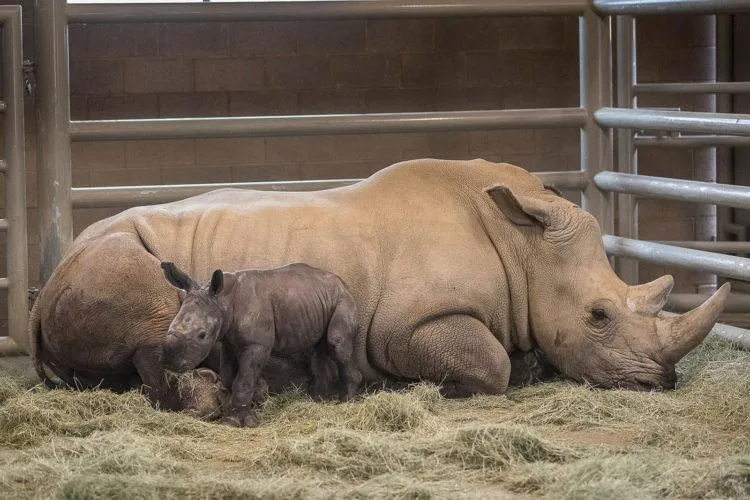Artificially Conceived Southern White Rhino Offers Hope for Critically Endangered Cousin
Scientists are working to bring northern white rhinos back from the brink by using southern females as surrogate mothers
/https://tf-cmsv2-smithsonianmag-media.s3.amazonaws.com/filer/f0/96/f0965bcc-a720-4500-9577-e1b88e553510/victorias-calf-1000px.jpg)
A southern white rhino named Victoria gave birth to an artificially conceived calf at the San Diego Zoo Safari Park last Sunday, marking a milestone in the fight to save the closely related northern white rhino from total extinction.
Conservation organization San Diego Zoo Global announced the successful delivery earlier this week. Per a press release, the male calf—newly dubbed Edward—is the first southern white rhino to be born through artificial insemination in North America.
Keepers inseminated Victoria with frozen semen from a male named Maoto last March following hormone-induced ovulation; 493 days later, the rhino gave birth after 30 minutes of labor.
As Natalie Rice reports for the Associated Press, both mother and calf will remain off exhibit for the foreseeable future to ensure they have enough time to bond. Eventually, staff will integrate Edward into the rhino community, introducing him to the five other females housed at the zoo’s Nikita Kahn Rhino Rescue Center. One of these females, Amani, is pregnant with her own artificially conceived offspring and is expected to give birth in November or December 2019.
In the statement, Barbara Durrant, director of reproductive science at San Diego Zoo Global, says, “Not only are we thankful for a healthy calf, but this birth is significant, as it also represents a critical step in our effort to save the northern white rhino from the brink of extinction.”
According to the World Wildlife Fund, northern and southern white rhinos are related but genetically distinct subspecies native to different regions of Africa. Just two members of the northern species—a 28-year-old female named Najin and her 18-year-old daughter Fatu—remain. Sudan, the world’s last male northern white rhino, died at age 45 in March 2018.

The animal’s southern counterpart, meanwhile, is the only surviving rhino species not classified as endangered. Boasting an upward-trending global population of some 20,000, southern white rhinos now fall under the category of “near threatened.”
Scientists hope to bring northern white rhinos back from the brink by using southern females as surrogates. As San Diego Zoo Global explains, this could be accomplished through reproductive techniques such as artificial insemination, in-vitro fertilization and embryo transfer. Before these conservation methods can be implemented, however, researchers must better sequence the northern species’ genome to clarify genetic differences from southern rhinos, as well as figure out how to convert preserved northern rhino cells into stem cells capable of developing into sperm and eggs.
Earlier this year, Joanna Jasińska reports for Polish outlet the First News, scientists working out of the country’s Chorzów zoo successfully transferred a hybrid embryo into a southern female. But this sample, created in a test tube using frozen northern rhino sperm and a southern rhino egg, has shown up smaller than expected on ultrasounds, and it remains uncertain whether the embryo will actually implant and result in a pregnancy.
The scientists’ long-term goal is to harvest eggs from both Najin and Fatu. If experiments with hybrid embryos prove successful, these eggs could then be used to create fully northern rhino embryos rather than northern rhino sperm and southern rhino egg embryos.
Per the AP’s Rice, if all goes well, a northern white rhino calf could once again roam the Earth within the next 10 to 20 years.
On Monday, Edward the day-old southern calf spent time with his mother in the zoo’s outdoor maternity yard. As Victoria wallowed in a new puddle of mud, her son lingered nearby. Soon, the San Diego Zoo Global Wildlife Conservancy writes, Victoria scooped up some mud and deposited it on Edward’s back, protecting his sensitive skin from the sun and insects.
“Victoria is doing a great job as a mother,” Durrant tells the Guardian’s Maanvi Singh. “And the calf is doing great. As soon as Victoria took the placenta off him, he was moving. He stood very quickly, and of course, he was very wobbly.”
“He is very cute,” the director concludes, “but he [also] has much greater significance.”
/https://tf-cmsv2-smithsonianmag-media.s3.amazonaws.com/accounts/headshot/mellon.png)
/https://tf-cmsv2-smithsonianmag-media.s3.amazonaws.com/accounts/headshot/mellon.png)